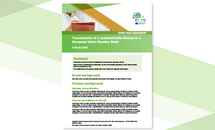Rapid Risk Assessment: Extreme rainfall and catastrophic floods in western Europe
Extreme rainfall on 14 and 15 July 2021 and subsequent flooding in Belgium, Germany, Luxembourg and the Netherlands has taken a high number of human lives and caused substantial damage to community infrastructure and the environment.
This rapid risk assessment focuses on the most common infectious diseases and health risks associated with flood-affected areas, taking into account evidence from previous similar events in Europe.
In addition to food- and waterborne diseases, zoonoses, vector-borne diseases, vaccine-preventable diseases and other health hazards associated with previous natural disasters in Europe, the current risk assessment also considers the challenges of responding to such a complex crisis during the COVID-19 pandemic.
Executive Summary
Risk assessment for the EU/EEA
The rapid responses put in place in the affected countries – such as providing access to healthcare, potable water and rescue shelters – has substantially mitigated the risk of infectious disease in the affected populations, as well as subsequent spread to other areas in the European Union and European Economic Area (EU/EEA).
In this rapid risk assessment, the risk of infectious diseases related to these events is stratified by population group (general population and vulnerable population) and by two levels of disease prevalence: very low or low (e.g. influenza, tetanus, measles, varicella, hepatitis A, Legionella and West Nile virus (WNV) infections, as well as other mosquito-borne diseases) and intermediate or high (e.g. SARS-CoV-2, Escherichia coli, Salmonella spp., Cryptosporidium spp. and norovirus infections).
Based on a combination of the probability of infection and the impact of infection, we assess the infectious disease risk that these events pose to the affected populations as ranging from very low or low for diseases that are uncommon in these countries and among otherwise healthy individuals, to moderate or high for diseases that are more probable among vulnerable individuals.
COVID-19 prevention is also given considerable emphasis, as the risk of SARS-CoV-2 infection spread in partially vaccinated or unvaccinated individuals is high, particularly among community members living in close contact with displaced people or among groups of displaced or evacuated people, due to overcrowding and the potential challenges of maintaining non-pharmaceutical interventions (NPIs). Although the risk of severe COVID-19 is low in fully vaccinated individuals, stringent implementation of NPIs is encouraged in all affected areas to prevent infection among partially vaccinated or unvaccinated individuals.
Options for response
Floods are the most common type of natural disaster in Europe. Flash floods are significant emergencies that are challenging to predict and result in remarkable destruction. Such events have become more common in recent years and are expected to occur more frequently due to climate change.
Affected regions and countries have faced an immediate surge of injuries and trauma, and may – depending on the scale of disruption and public health capacity – consider setting up syndromic and event-based surveillance systems. Suspected cases of an agreed upon list of infectious diseases (including clusters of respiratory and gastrointestinal symptoms, rashes, etc.) would need to be reported to local and national public health authorities immediately to prompt a rapid response.
COVID-19 vaccination should remain a priority and disruptions to vaccine delivery in the flood-affected areas should be mitigated or resolved as quickly as possible. NPIs such as hand and respiratory hygiene, physical distancing and the wearing of face masks remain essential, particularly for displaced populations housed in shelters where physical distancing cannot be maintained. Testing and contact tracing should also remain a priority.
Collaboration between public health authorities and other local authorities (e.g. civil protection agencies, municipal governments) is needed to ensure access to clean water as soon as possible in the affected communities. Water management plans should minimise the risk for Legionella growth. Flooded areas also need to be monitored for increases in mosquito populations and control measures may need to be considered. Mechanisms to achieve early detection and awareness of disease clusters should be enhanced and availability of immunisations should be ensured.
Risk communication to the affected communities is a critical part of the response to the flood crisis and it should be undertaken in a structured way that clearly delivers core messages and listens to the affected communities’ needs. Key principles of successful risk communication include the identification of a trusted spokesperson and the delivery of clear and actionable advice, with messaging tailored to the needs of the affected communities.
Download






